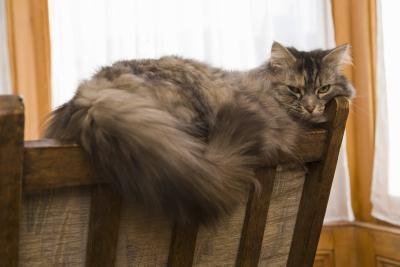Every now and then, a cat develops anemia that is so severe that a transfusion is required to save its life. Cats have distinct blood types, so it is important to make sure that a severely anemic cat receives the proper blood type. Blood types in cats are classified similar to those in people. There’s type A, type B, and type AB. There is no type O, however. Most cats are type A. Purebred cats have an increased probability of being type B. Type AB is exceedingly rare.
Cats have, pre-formed in their bloodstream, antibodies against the opposite blood type. So, cats with blood type A have antibodies against type B. Cats with blood type B have antibodies against blood type A. If you transfuse a type-A cat with a unit of type B blood, a transfusion reaction will occur and the cat will become sick. The antibodies against the type B blood will attack the transfused red blood cells, shortening their lifespan. It becomes worse if you give a type-B cat a unit of type A blood. Cats that are blood type B have lots of antibodies against type A blood. The transfusion reaction is immediate and severe, and sometimes fatal.
So, what would happen if you were to give a cat a unit of dog blood?
If giving blood from the same species, but different type, can cause a severe transfusion reaction, you would think that giving blood from an entirely different species would be instantly fatal. Surprisingly, this is not the case. A recent article in the Journal of Feline Medicine and Surgery reviewed the number of cases of canine to feline “xenotransfusion” (transfusion of blood from another species).
The first study of dog-to-cat blood transfusion was reported way back in 1962. The study described 22 cases. In all cases, a cross-match was performed before the transfusion. A cross-match is a test that is performed before the transfusion, to see if the donor’s blood is compatible with the recipient. Plasma from the cat (recipient) is mixed with red blood cells from the dog (donor). If the dog red blood cells agglutinate (clump), it suggests that there are antibodies in the recipient’s plasma against the red cells of the donor. In all 22 cases, there were no signs of blood incompatibility before the transfusion was given. The cats were then given canine blood intravenously. No cat developed any transfusion reactions during the transfusion or in the following day. Cross-match tests were again performed after the transfusion. This time, the dog blood agglutinated when mixed with the cat’s plasma, starting on day four after the transfusion. This suggests that the cat produced antibodies against the dog blood. These antibodies were detectable by day four. Twenty of the cats received a second blood transfusion. Four of them received dog blood within 4 days of the initial transfusion. These cats did fine. Sixteen cats were given a second unit of canine blood between 6 and 100 days after the first transfusion. All 16 developed some type of transfusion reaction, with 10 cats dying, 9 of them within minutes-to-hours of the second transfusion.
A second study the following year (1963) described seven cats that were transfused with dog blood. No adverse reactions were noted. The average lifespan of the transfused dog red blood cells was about 3.6 days (vs. a 30 day lifespan of feline red blood cells given to another cat of the same blood type.)
A third report, in 1968, described the experimental transfusion of canine blood into four cats. All four cats did well. Blood compatibility tests were basically fine before the transfusion, but showed incompatibility 6 to 7 days after the initial transfusion. A few cats in the study received a second transfusion within 4 days of the initial transfusion and did fine. One cat received dog blood for a second time seven days after the first transfusion and died a few hours later. The same report also described the transfusion of canine blood into 20 cats that were suffering from severe anemia. In 18 cases, the sick cats that needed the transfusion showed rapid improvement, with only mild transfusion reactions occurring in two cases. Fifteen cats survived their initial hospitalization and transfusion. Five died during the transfusion or in the following days, but this was due to their underlying disease, not their transfusion.
A fourth study in 1969 described 8 cats receiving dog blood. Pre-transfusion blood compatibility tests were performed, and no incompatibility was detected. The transfusions proceeded without incident. Compatibility tests performed between the cat’s plasma and the donor dog’s red blood cells showed incompatibility starting on the 6th day after the transfusion. Cats who received additional dog blood within 6 days of the transfusion had no adverse effects. All cats transfused with dog blood 7 days or more after the first transfusion (they didn’t say how many cats this was) died very quickly.
The reports described above were all decades ago. As we learned more about transfusion medicine, the crazy practice of xenotransfusion was discontinued. However, an interesting case report was published in 2004. A cat of blood type B was admitted to a referral center with severe anemia. A donor cat with blood type B was not available. Oxyglobin, a synthetic hemoglobin that can be given in cases of severe anemia, was also not available. Rather than let the cat die from anemia, the cat was transfused with blood from a Labrador retriever as a last resort. Cross-matching was performed, no incompatibility was detected, and the cat was given a test dose of 1 ml. of blood to see what happens. No adverse reaction occurred, so a total of 130 ml. of canine blood was given, in small doses, over a 48 hour period. The cat’s condition improved considerably and it became stable enough to undergo general anesthesia so that additional diagnostic tests could be performed. Unfortunately, this led to a diagnosis of leukemia, and the cat was euthanized.
Based on the cases described above, it is apparent that cats do not have naturally occurring antibodies against canine red blood cells. In an emergency situation where there is no compatible feline blood, or there is no hemoglobin-based oxygen carrier solution like Oxyglobin available, a single transfusion with canine blood can be given to cats with no expected severe acute transfusion reaction. Between 4 and 7 days after the initial transfusion, antibodies against the canine red blood cells are produced. If a second transfusion is performed seven days or more after the first one, the transfused red blood cells will be rapidly destroyed and the cat will undergo a severe transfusion reaction that may result in death. The red blood cells given in the initial transfusion don’t last very long; on average, about 4 days. This is in contrast to giving a cat compatible feline blood; those blood cells have a lifespan of 30 days. Clearly, giving dog blood to a cat is not recommended as a routine procedure, but it may allow short-term stabilization to allow additional diagnostic procedures, or to buy time while attempting to procure compatible feline blood. If this is done, it should be done only ONCE. Any additional transfusion with canine blood later than 4 to 6 days after the first transfusion is expected to cause a severe transfusion reaction that, in many cases, is fatal.
See also:
Blood Transfusions




































